IMAT5205 System Analysis & Design: New System Development Analysis
VerifiedAdded on 2023/04/21
|9
|2353
|358
Report
AI Summary
This report provides a comprehensive analysis of new system development, addressing the increasing reliance on software components developed outside client organizations. It explores the activities of analysis and design, covering system analysis techniques like data gathering and modeling, system design phases including preliminary and detailed design, system development processes with make or buy decisions, and implementation and maintenance strategies. The report emphasizes the importance of preliminary investigation, cost-benefit analysis, and structured methodologies in managing system development projects. It also touches upon software development models and the role of UML in modern software design, concluding with the significance of system maintenance and periodic evaluations. The student document is available on Desklib, a platform offering study tools, past papers, and solved assignments.
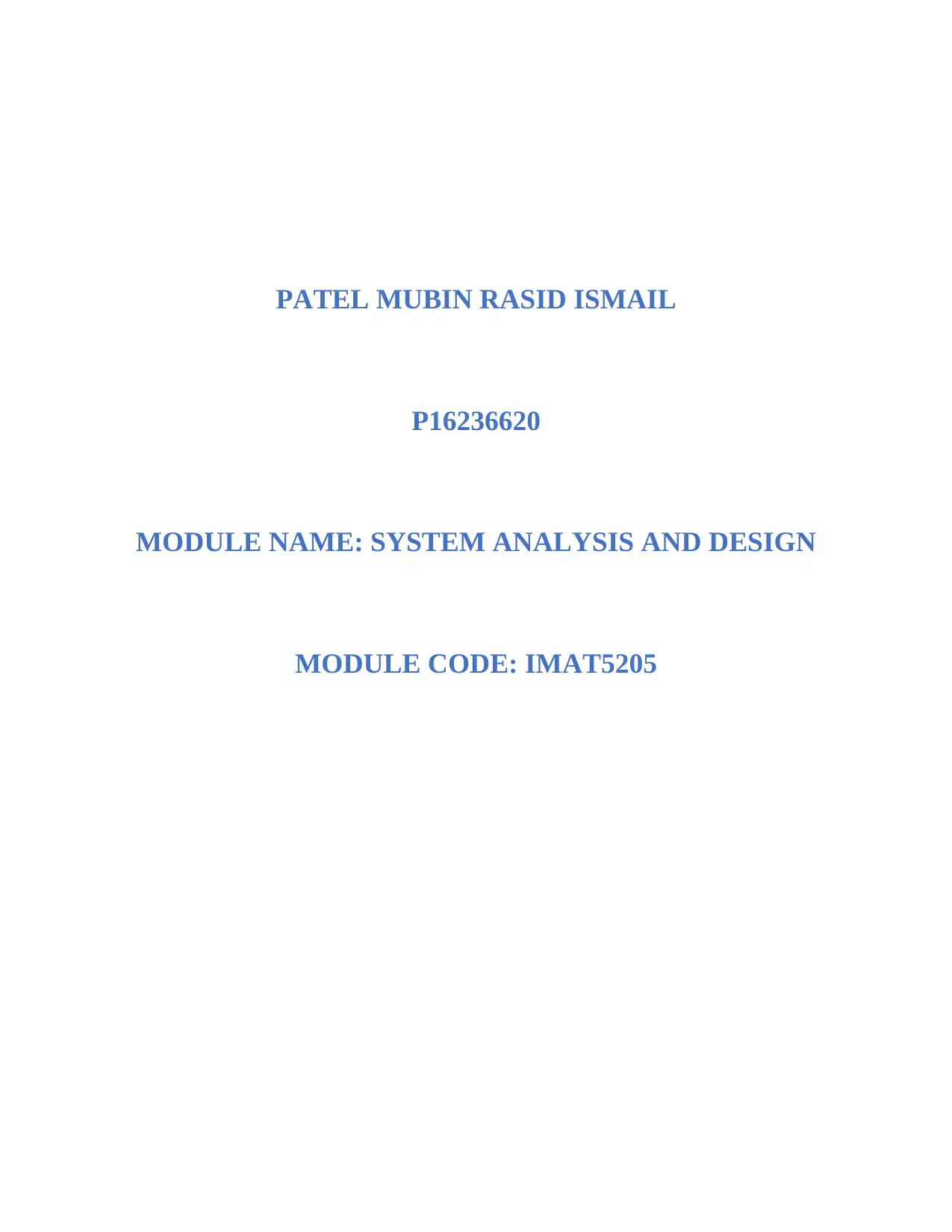
PATEL MUBIN RASID ISMAIL
P16236620
MODULE NAME: SYSTEM ANALYSIS AND DESIGN
MODULE CODE: IMAT5205
P16236620
MODULE NAME: SYSTEM ANALYSIS AND DESIGN
MODULE CODE: IMAT5205
Paraphrase This Document
Need a fresh take? Get an instant paraphrase of this document with our AI Paraphraser
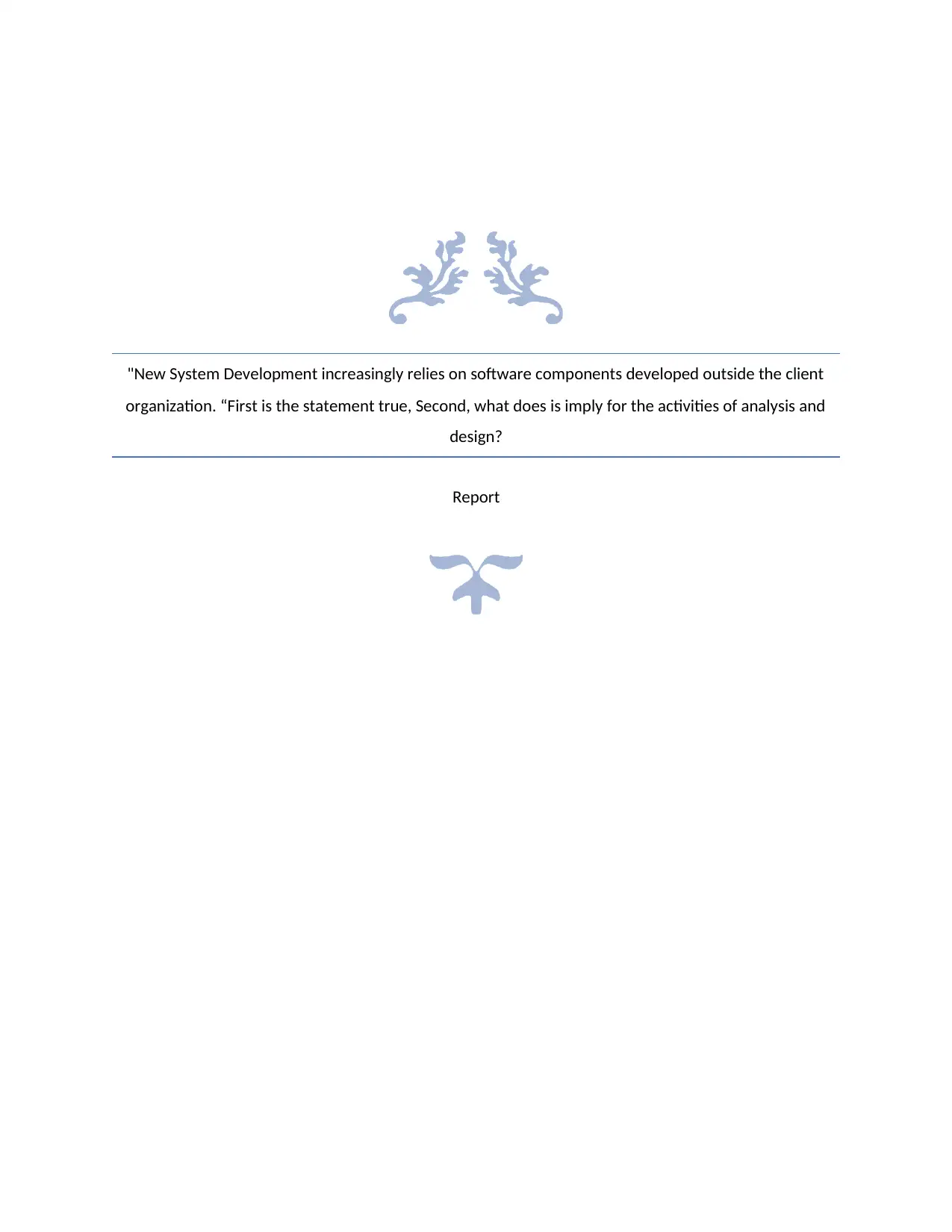
"New System Development increasingly relies on software components developed outside the client
organization. “First is the statement true, Second, what does is imply for the activities of analysis and
design?
Report
organization. “First is the statement true, Second, what does is imply for the activities of analysis and
design?
Report

Contents
Introduction......................................................................................................................................1
System Analysis...............................................................................................................................1
Designing the system.......................................................................................................................2
Developing a System.......................................................................................................................3
Implementation & Maintaining the system.....................................................................................4
Conclusion.......................................................................................................................................4
References........................................................................................................................................5
Introduction......................................................................................................................................1
System Analysis...............................................................................................................................1
Designing the system.......................................................................................................................2
Developing a System.......................................................................................................................3
Implementation & Maintaining the system.....................................................................................4
Conclusion.......................................................................................................................................4
References........................................................................................................................................5
⊘ This is a preview!⊘
Do you want full access?
Subscribe today to unlock all pages.

Trusted by 1+ million students worldwide
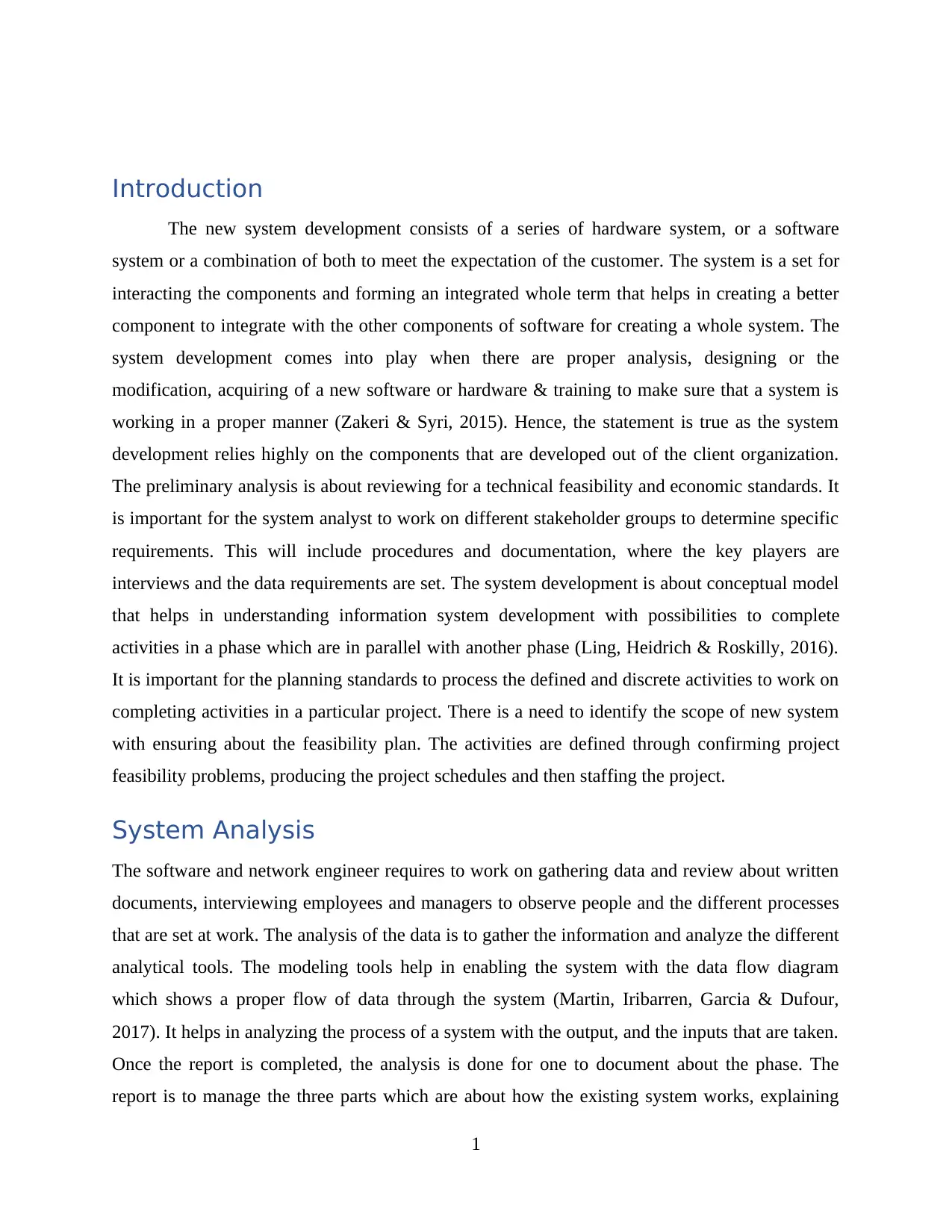
Introduction
The new system development consists of a series of hardware system, or a software
system or a combination of both to meet the expectation of the customer. The system is a set for
interacting the components and forming an integrated whole term that helps in creating a better
component to integrate with the other components of software for creating a whole system. The
system development comes into play when there are proper analysis, designing or the
modification, acquiring of a new software or hardware & training to make sure that a system is
working in a proper manner (Zakeri & Syri, 2015). Hence, the statement is true as the system
development relies highly on the components that are developed out of the client organization.
The preliminary analysis is about reviewing for a technical feasibility and economic standards. It
is important for the system analyst to work on different stakeholder groups to determine specific
requirements. This will include procedures and documentation, where the key players are
interviews and the data requirements are set. The system development is about conceptual model
that helps in understanding information system development with possibilities to complete
activities in a phase which are in parallel with another phase (Ling, Heidrich & Roskilly, 2016).
It is important for the planning standards to process the defined and discrete activities to work on
completing activities in a particular project. There is a need to identify the scope of new system
with ensuring about the feasibility plan. The activities are defined through confirming project
feasibility problems, producing the project schedules and then staffing the project.
System Analysis
The software and network engineer requires to work on gathering data and review about written
documents, interviewing employees and managers to observe people and the different processes
that are set at work. The analysis of the data is to gather the information and analyze the different
analytical tools. The modeling tools help in enabling the system with the data flow diagram
which shows a proper flow of data through the system (Martin, Iribarren, Garcia & Dufour,
2017). It helps in analyzing the process of a system with the output, and the inputs that are taken.
Once the report is completed, the analysis is done for one to document about the phase. The
report is to manage the three parts which are about how the existing system works, explaining
1
The new system development consists of a series of hardware system, or a software
system or a combination of both to meet the expectation of the customer. The system is a set for
interacting the components and forming an integrated whole term that helps in creating a better
component to integrate with the other components of software for creating a whole system. The
system development comes into play when there are proper analysis, designing or the
modification, acquiring of a new software or hardware & training to make sure that a system is
working in a proper manner (Zakeri & Syri, 2015). Hence, the statement is true as the system
development relies highly on the components that are developed out of the client organization.
The preliminary analysis is about reviewing for a technical feasibility and economic standards. It
is important for the system analyst to work on different stakeholder groups to determine specific
requirements. This will include procedures and documentation, where the key players are
interviews and the data requirements are set. The system development is about conceptual model
that helps in understanding information system development with possibilities to complete
activities in a phase which are in parallel with another phase (Ling, Heidrich & Roskilly, 2016).
It is important for the planning standards to process the defined and discrete activities to work on
completing activities in a particular project. There is a need to identify the scope of new system
with ensuring about the feasibility plan. The activities are defined through confirming project
feasibility problems, producing the project schedules and then staffing the project.
System Analysis
The software and network engineer requires to work on gathering data and review about written
documents, interviewing employees and managers to observe people and the different processes
that are set at work. The analysis of the data is to gather the information and analyze the different
analytical tools. The modeling tools help in enabling the system with the data flow diagram
which shows a proper flow of data through the system (Martin, Iribarren, Garcia & Dufour,
2017). It helps in analyzing the process of a system with the output, and the inputs that are taken.
Once the report is completed, the analysis is done for one to document about the phase. The
report is to manage the three parts which are about how the existing system works, explaining
1
Paraphrase This Document
Need a fresh take? Get an instant paraphrase of this document with our AI Paraphraser
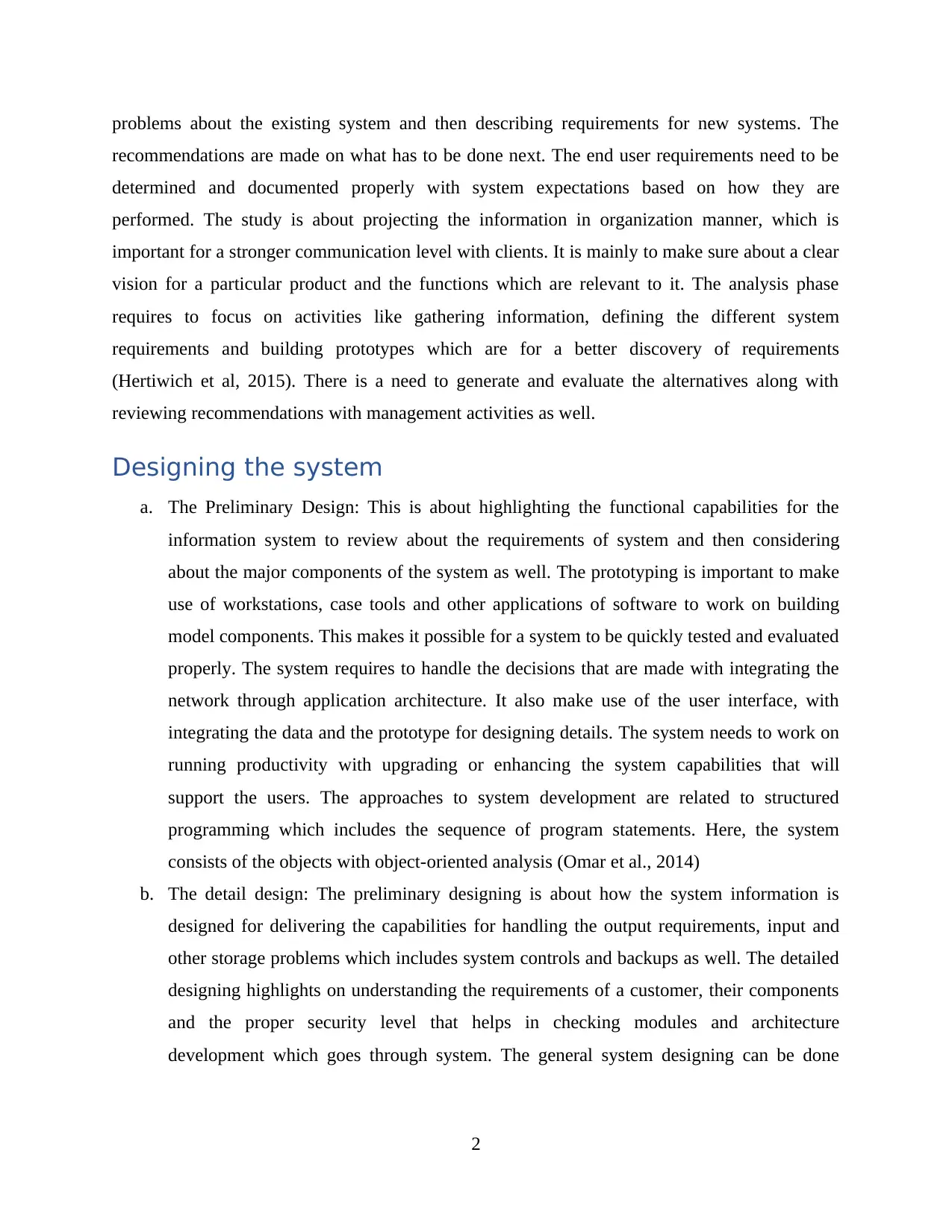
problems about the existing system and then describing requirements for new systems. The
recommendations are made on what has to be done next. The end user requirements need to be
determined and documented properly with system expectations based on how they are
performed. The study is about projecting the information in organization manner, which is
important for a stronger communication level with clients. It is mainly to make sure about a clear
vision for a particular product and the functions which are relevant to it. The analysis phase
requires to focus on activities like gathering information, defining the different system
requirements and building prototypes which are for a better discovery of requirements
(Hertiwich et al, 2015). There is a need to generate and evaluate the alternatives along with
reviewing recommendations with management activities as well.
Designing the system
a. The Preliminary Design: This is about highlighting the functional capabilities for the
information system to review about the requirements of system and then considering
about the major components of the system as well. The prototyping is important to make
use of workstations, case tools and other applications of software to work on building
model components. This makes it possible for a system to be quickly tested and evaluated
properly. The system requires to handle the decisions that are made with integrating the
network through application architecture. It also make use of the user interface, with
integrating the data and the prototype for designing details. The system needs to work on
running productivity with upgrading or enhancing the system capabilities that will
support the users. The approaches to system development are related to structured
programming which includes the sequence of program statements. Here, the system
consists of the objects with object-oriented analysis (Omar et al., 2014)
b. The detail design: The preliminary designing is about how the system information is
designed for delivering the capabilities for handling the output requirements, input and
other storage problems which includes system controls and backups as well. The detailed
designing highlights on understanding the requirements of a customer, their components
and the proper security level that helps in checking modules and architecture
development which goes through system. The general system designing can be done
2
recommendations are made on what has to be done next. The end user requirements need to be
determined and documented properly with system expectations based on how they are
performed. The study is about projecting the information in organization manner, which is
important for a stronger communication level with clients. It is mainly to make sure about a clear
vision for a particular product and the functions which are relevant to it. The analysis phase
requires to focus on activities like gathering information, defining the different system
requirements and building prototypes which are for a better discovery of requirements
(Hertiwich et al, 2015). There is a need to generate and evaluate the alternatives along with
reviewing recommendations with management activities as well.
Designing the system
a. The Preliminary Design: This is about highlighting the functional capabilities for the
information system to review about the requirements of system and then considering
about the major components of the system as well. The prototyping is important to make
use of workstations, case tools and other applications of software to work on building
model components. This makes it possible for a system to be quickly tested and evaluated
properly. The system requires to handle the decisions that are made with integrating the
network through application architecture. It also make use of the user interface, with
integrating the data and the prototype for designing details. The system needs to work on
running productivity with upgrading or enhancing the system capabilities that will
support the users. The approaches to system development are related to structured
programming which includes the sequence of program statements. Here, the system
consists of the objects with object-oriented analysis (Omar et al., 2014)
b. The detail design: The preliminary designing is about how the system information is
designed for delivering the capabilities for handling the output requirements, input and
other storage problems which includes system controls and backups as well. The detailed
designing highlights on understanding the requirements of a customer, their components
and the proper security level that helps in checking modules and architecture
development which goes through system. The general system designing can be done
2
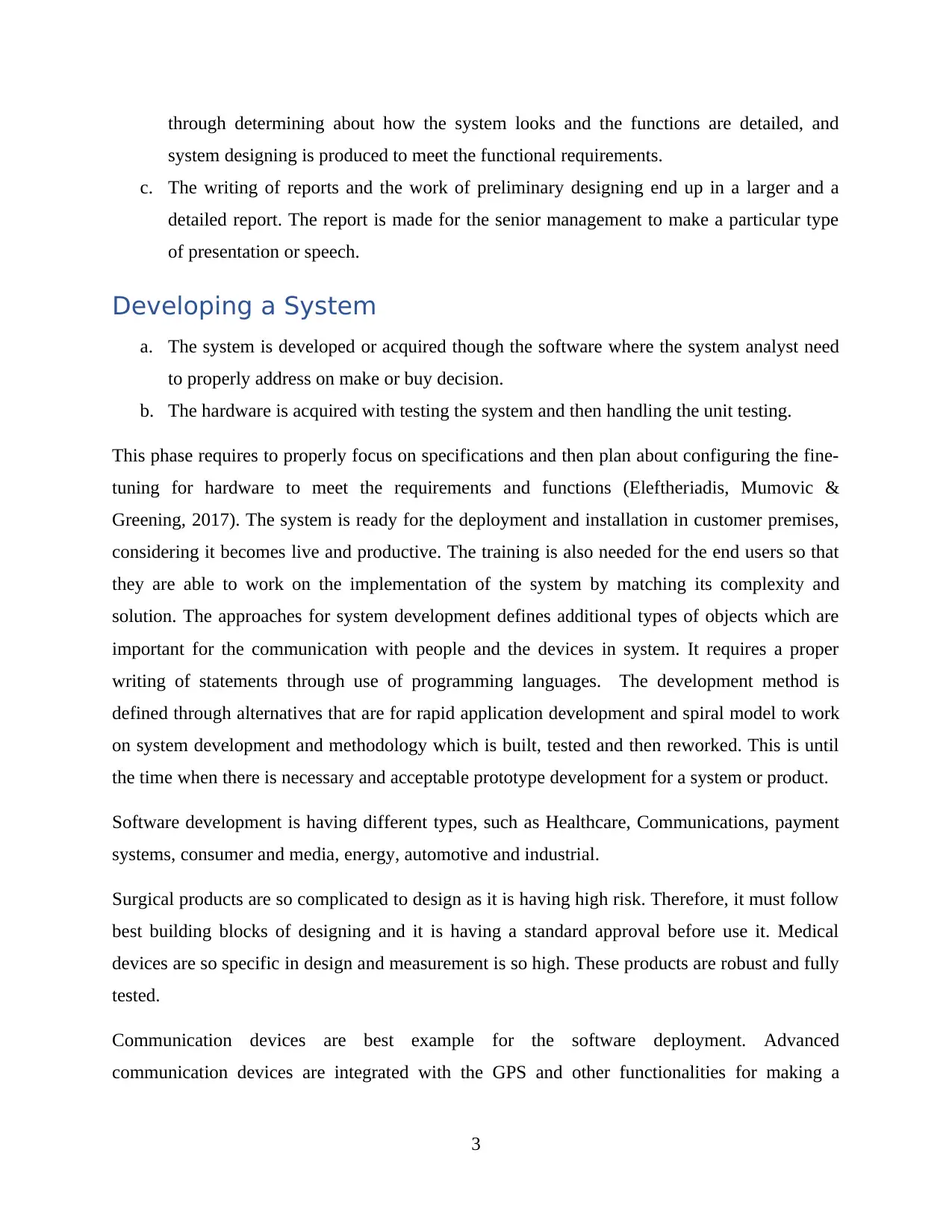
through determining about how the system looks and the functions are detailed, and
system designing is produced to meet the functional requirements.
c. The writing of reports and the work of preliminary designing end up in a larger and a
detailed report. The report is made for the senior management to make a particular type
of presentation or speech.
Developing a System
a. The system is developed or acquired though the software where the system analyst need
to properly address on make or buy decision.
b. The hardware is acquired with testing the system and then handling the unit testing.
This phase requires to properly focus on specifications and then plan about configuring the fine-
tuning for hardware to meet the requirements and functions (Eleftheriadis, Mumovic &
Greening, 2017). The system is ready for the deployment and installation in customer premises,
considering it becomes live and productive. The training is also needed for the end users so that
they are able to work on the implementation of the system by matching its complexity and
solution. The approaches for system development defines additional types of objects which are
important for the communication with people and the devices in system. It requires a proper
writing of statements through use of programming languages. The development method is
defined through alternatives that are for rapid application development and spiral model to work
on system development and methodology which is built, tested and then reworked. This is until
the time when there is necessary and acceptable prototype development for a system or product.
Software development is having different types, such as Healthcare, Communications, payment
systems, consumer and media, energy, automotive and industrial.
Surgical products are so complicated to design as it is having high risk. Therefore, it must follow
best building blocks of designing and it is having a standard approval before use it. Medical
devices are so specific in design and measurement is so high. These products are robust and fully
tested.
Communication devices are best example for the software deployment. Advanced
communication devices are integrated with the GPS and other functionalities for making a
3
system designing is produced to meet the functional requirements.
c. The writing of reports and the work of preliminary designing end up in a larger and a
detailed report. The report is made for the senior management to make a particular type
of presentation or speech.
Developing a System
a. The system is developed or acquired though the software where the system analyst need
to properly address on make or buy decision.
b. The hardware is acquired with testing the system and then handling the unit testing.
This phase requires to properly focus on specifications and then plan about configuring the fine-
tuning for hardware to meet the requirements and functions (Eleftheriadis, Mumovic &
Greening, 2017). The system is ready for the deployment and installation in customer premises,
considering it becomes live and productive. The training is also needed for the end users so that
they are able to work on the implementation of the system by matching its complexity and
solution. The approaches for system development defines additional types of objects which are
important for the communication with people and the devices in system. It requires a proper
writing of statements through use of programming languages. The development method is
defined through alternatives that are for rapid application development and spiral model to work
on system development and methodology which is built, tested and then reworked. This is until
the time when there is necessary and acceptable prototype development for a system or product.
Software development is having different types, such as Healthcare, Communications, payment
systems, consumer and media, energy, automotive and industrial.
Surgical products are so complicated to design as it is having high risk. Therefore, it must follow
best building blocks of designing and it is having a standard approval before use it. Medical
devices are so specific in design and measurement is so high. These products are robust and fully
tested.
Communication devices are best example for the software deployment. Advanced
communication devices are integrated with the GPS and other functionalities for making a
3
⊘ This is a preview!⊘
Do you want full access?
Subscribe today to unlock all pages.

Trusted by 1+ million students worldwide
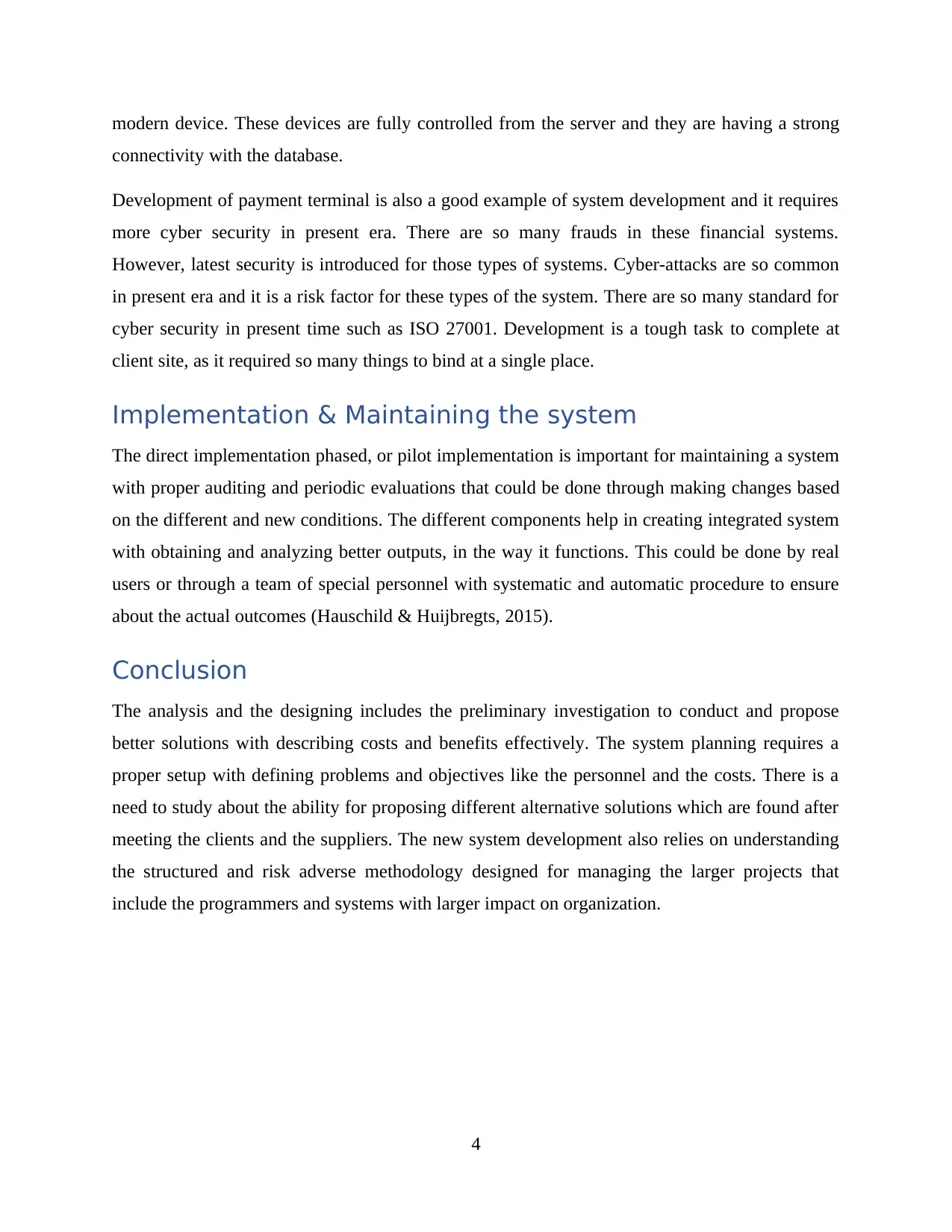
modern device. These devices are fully controlled from the server and they are having a strong
connectivity with the database.
Development of payment terminal is also a good example of system development and it requires
more cyber security in present era. There are so many frauds in these financial systems.
However, latest security is introduced for those types of systems. Cyber-attacks are so common
in present era and it is a risk factor for these types of the system. There are so many standard for
cyber security in present time such as ISO 27001. Development is a tough task to complete at
client site, as it required so many things to bind at a single place.
Implementation & Maintaining the system
The direct implementation phased, or pilot implementation is important for maintaining a system
with proper auditing and periodic evaluations that could be done through making changes based
on the different and new conditions. The different components help in creating integrated system
with obtaining and analyzing better outputs, in the way it functions. This could be done by real
users or through a team of special personnel with systematic and automatic procedure to ensure
about the actual outcomes (Hauschild & Huijbregts, 2015).
Conclusion
The analysis and the designing includes the preliminary investigation to conduct and propose
better solutions with describing costs and benefits effectively. The system planning requires a
proper setup with defining problems and objectives like the personnel and the costs. There is a
need to study about the ability for proposing different alternative solutions which are found after
meeting the clients and the suppliers. The new system development also relies on understanding
the structured and risk adverse methodology designed for managing the larger projects that
include the programmers and systems with larger impact on organization.
4
connectivity with the database.
Development of payment terminal is also a good example of system development and it requires
more cyber security in present era. There are so many frauds in these financial systems.
However, latest security is introduced for those types of systems. Cyber-attacks are so common
in present era and it is a risk factor for these types of the system. There are so many standard for
cyber security in present time such as ISO 27001. Development is a tough task to complete at
client site, as it required so many things to bind at a single place.
Implementation & Maintaining the system
The direct implementation phased, or pilot implementation is important for maintaining a system
with proper auditing and periodic evaluations that could be done through making changes based
on the different and new conditions. The different components help in creating integrated system
with obtaining and analyzing better outputs, in the way it functions. This could be done by real
users or through a team of special personnel with systematic and automatic procedure to ensure
about the actual outcomes (Hauschild & Huijbregts, 2015).
Conclusion
The analysis and the designing includes the preliminary investigation to conduct and propose
better solutions with describing costs and benefits effectively. The system planning requires a
proper setup with defining problems and objectives like the personnel and the costs. There is a
need to study about the ability for proposing different alternative solutions which are found after
meeting the clients and the suppliers. The new system development also relies on understanding
the structured and risk adverse methodology designed for managing the larger projects that
include the programmers and systems with larger impact on organization.
4
Paraphrase This Document
Need a fresh take? Get an instant paraphrase of this document with our AI Paraphraser
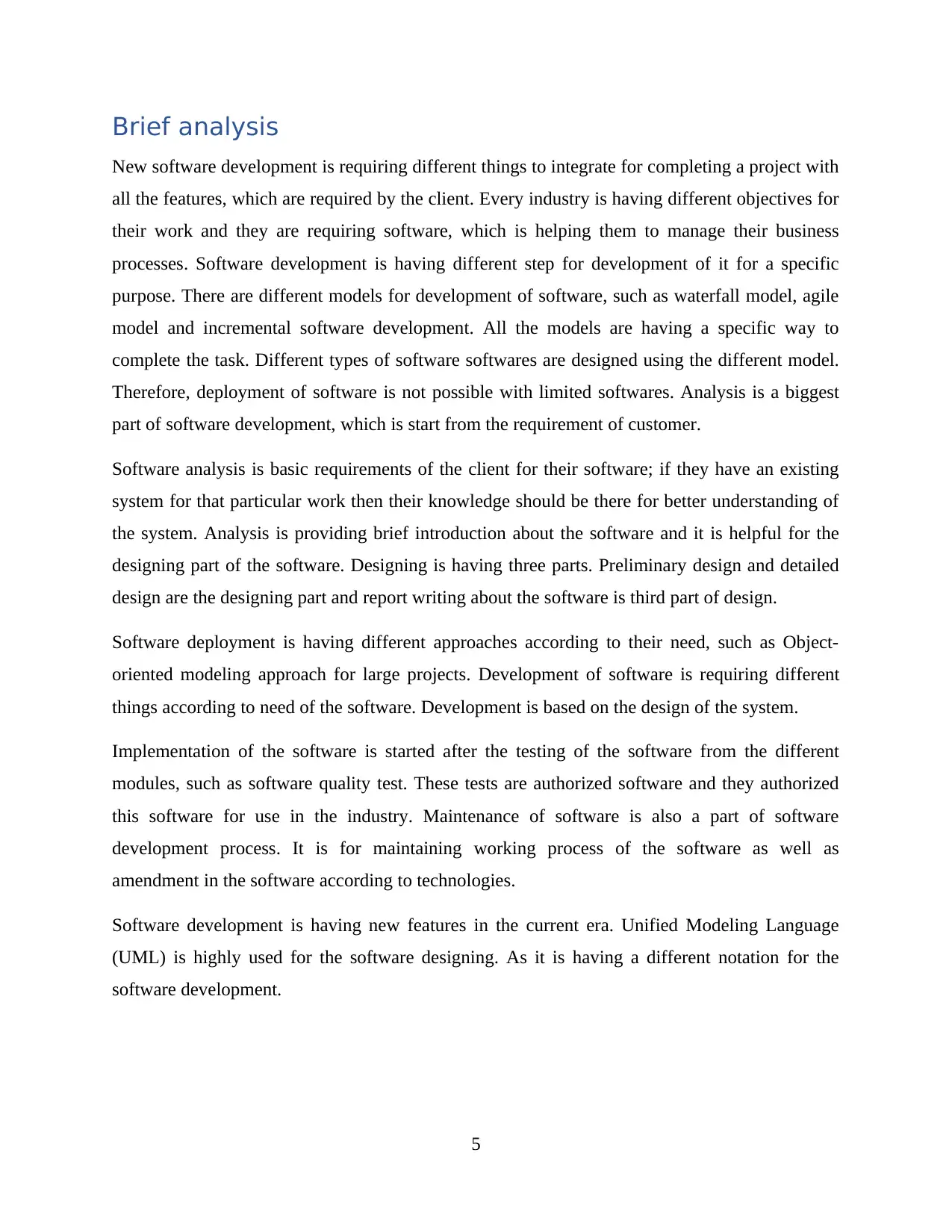
Brief analysis
New software development is requiring different things to integrate for completing a project with
all the features, which are required by the client. Every industry is having different objectives for
their work and they are requiring software, which is helping them to manage their business
processes. Software development is having different step for development of it for a specific
purpose. There are different models for development of software, such as waterfall model, agile
model and incremental software development. All the models are having a specific way to
complete the task. Different types of software softwares are designed using the different model.
Therefore, deployment of software is not possible with limited softwares. Analysis is a biggest
part of software development, which is start from the requirement of customer.
Software analysis is basic requirements of the client for their software; if they have an existing
system for that particular work then their knowledge should be there for better understanding of
the system. Analysis is providing brief introduction about the software and it is helpful for the
designing part of the software. Designing is having three parts. Preliminary design and detailed
design are the designing part and report writing about the software is third part of design.
Software deployment is having different approaches according to their need, such as Object-
oriented modeling approach for large projects. Development of software is requiring different
things according to need of the software. Development is based on the design of the system.
Implementation of the software is started after the testing of the software from the different
modules, such as software quality test. These tests are authorized software and they authorized
this software for use in the industry. Maintenance of software is also a part of software
development process. It is for maintaining working process of the software as well as
amendment in the software according to technologies.
Software development is having new features in the current era. Unified Modeling Language
(UML) is highly used for the software designing. As it is having a different notation for the
software development.
5
New software development is requiring different things to integrate for completing a project with
all the features, which are required by the client. Every industry is having different objectives for
their work and they are requiring software, which is helping them to manage their business
processes. Software development is having different step for development of it for a specific
purpose. There are different models for development of software, such as waterfall model, agile
model and incremental software development. All the models are having a specific way to
complete the task. Different types of software softwares are designed using the different model.
Therefore, deployment of software is not possible with limited softwares. Analysis is a biggest
part of software development, which is start from the requirement of customer.
Software analysis is basic requirements of the client for their software; if they have an existing
system for that particular work then their knowledge should be there for better understanding of
the system. Analysis is providing brief introduction about the software and it is helpful for the
designing part of the software. Designing is having three parts. Preliminary design and detailed
design are the designing part and report writing about the software is third part of design.
Software deployment is having different approaches according to their need, such as Object-
oriented modeling approach for large projects. Development of software is requiring different
things according to need of the software. Development is based on the design of the system.
Implementation of the software is started after the testing of the software from the different
modules, such as software quality test. These tests are authorized software and they authorized
this software for use in the industry. Maintenance of software is also a part of software
development process. It is for maintaining working process of the software as well as
amendment in the software according to technologies.
Software development is having new features in the current era. Unified Modeling Language
(UML) is highly used for the software designing. As it is having a different notation for the
software development.
5

References
Eleftheriadis, S., Mumovic, D. and Greening, P., 2017. Life cycle energy efficiency in building
structures: A review of current developments and future outlooks based on BIM
capabilities. Renewable and Sustainable Energy Reviews, 67, pp.811-825.
Hauschild, M.Z. and Huijbregts, M.A., 2015. Introducing life cycle impact assessment. In Life Cycle
Impact Assessment(pp. 1-16). Springer, Dordrecht.
Hertwich, E.G., Gibon, T., Bouman, E.A., Arvesen, A., Suh, S., Heath, G.A., Bergesen, J.D.,
Ramirez, A., Vega, M.I. and Shi, L., 2015. Integrated life-cycle assessment of electricity-supply
scenarios confirms global environmental benefit of low-carbon technologies. Proceedings of the
National Academy of Sciences, 112(20), pp.6277-6282.
Ling-Chin, J., Heidrich, O. and Roskilly, A.P., 2016. Life cycle assessment (LCA)–from
analysing methodology development to introducing an LCA framework for marine photovoltaic
(PV) systems. Renewable and Sustainable Energy Reviews, 59, pp.352-378.
Martín-Gamboa, M., Iribarren, D., García-Gusano, D. and Dufour, J., 2017. A review of life-
cycle approaches coupled with data envelopment analysis within multi-criteria decision analysis
for sustainability assessment of energy systems. Journal of Cleaner Production, 150, pp.164-
174.
Omar, N., Monem, M.A., Firouz, Y., Salminen, J., Smekens, J., Hegazy, O., Gaulous, H.,
Mulder, G., Van den Bossche, P., Coosemans, T. and Van Mierlo, J., 2014. Lithium iron
phosphate based battery–assessment of the aging parameters and development of cycle life
model. Applied Energy, 113, pp.1575-1585.
Zakeri, B. and Syri, S., 2015. Electrical energy storage systems: A comparative life cycle cost
analysis. Renewable and Sustainable Energy Reviews, 42, pp.569-596.
6
Eleftheriadis, S., Mumovic, D. and Greening, P., 2017. Life cycle energy efficiency in building
structures: A review of current developments and future outlooks based on BIM
capabilities. Renewable and Sustainable Energy Reviews, 67, pp.811-825.
Hauschild, M.Z. and Huijbregts, M.A., 2015. Introducing life cycle impact assessment. In Life Cycle
Impact Assessment(pp. 1-16). Springer, Dordrecht.
Hertwich, E.G., Gibon, T., Bouman, E.A., Arvesen, A., Suh, S., Heath, G.A., Bergesen, J.D.,
Ramirez, A., Vega, M.I. and Shi, L., 2015. Integrated life-cycle assessment of electricity-supply
scenarios confirms global environmental benefit of low-carbon technologies. Proceedings of the
National Academy of Sciences, 112(20), pp.6277-6282.
Ling-Chin, J., Heidrich, O. and Roskilly, A.P., 2016. Life cycle assessment (LCA)–from
analysing methodology development to introducing an LCA framework for marine photovoltaic
(PV) systems. Renewable and Sustainable Energy Reviews, 59, pp.352-378.
Martín-Gamboa, M., Iribarren, D., García-Gusano, D. and Dufour, J., 2017. A review of life-
cycle approaches coupled with data envelopment analysis within multi-criteria decision analysis
for sustainability assessment of energy systems. Journal of Cleaner Production, 150, pp.164-
174.
Omar, N., Monem, M.A., Firouz, Y., Salminen, J., Smekens, J., Hegazy, O., Gaulous, H.,
Mulder, G., Van den Bossche, P., Coosemans, T. and Van Mierlo, J., 2014. Lithium iron
phosphate based battery–assessment of the aging parameters and development of cycle life
model. Applied Energy, 113, pp.1575-1585.
Zakeri, B. and Syri, S., 2015. Electrical energy storage systems: A comparative life cycle cost
analysis. Renewable and Sustainable Energy Reviews, 42, pp.569-596.
6
⊘ This is a preview!⊘
Do you want full access?
Subscribe today to unlock all pages.

Trusted by 1+ million students worldwide
1 out of 9
Related Documents
Your All-in-One AI-Powered Toolkit for Academic Success.
+13062052269
info@desklib.com
Available 24*7 on WhatsApp / Email
![[object Object]](/_next/static/media/star-bottom.7253800d.svg)
Unlock your academic potential
Copyright © 2020–2025 A2Z Services. All Rights Reserved. Developed and managed by ZUCOL.





